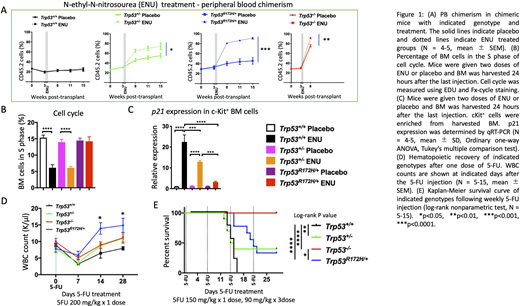Introduction. Mutations in TP53 are common (~18%) in patients with myelodysplastic syndrome (MDS) and acute myeloid leukemia and often undergo loss of heterozygosity. Our understanding of the hematopoietic consequences of expressing mutant TP53-R175H, one of the most common mutations in MDS, is incomplete. In addition, whether TP53-R175H confers a loss-of-function, gain-of-function, or dominant-negative effect in response to chemotherapy has not been fully explored.
Methods. We used a constitutive knock-in mouse model expressing TRP53-R172H (G-to-A substitution at nucleotide 515), corresponding to human mutant TP53-R175H. We generated Trp53R172H/+ and Trp53R172H/R172H mice and compared them to wild type (WT), Trp53+/-, and Trp53-/- mice. Peripheral blood (PB) and bone marrow (BM) was analyzed in non-BM transplant conditions, following a non-competitive BM transplant, and following a competitive BM transplant with or without exposure to N-ethyl-N-nitrosourea (ENU) and 5-fluorouracil (5FU).
Results. BM hematopoietic stem and progenitor cells (HSPC), including LSK-SLAM cells, were increased in Trp53+/- and Trp53-/-mice (n=4-8, 8-15 weeks old, P<0.01), but not Trp53R172H/+ and Trp53R172H/R172H mice. In order to study the hematopoietic cell-intrinsic properties of mutant TRP53, we transplanted whole BM into lethally irradiated congenic recipient mice and monitored survival. The median overall survival was dependent on the Trp53 genotype of donor cells: WT cells (100% survival at 1 year), Trp53R172H/+ (60% survival at 1 year), Trp53+/- (31 weeks), Trp53-/- (20 weeks), and Trp53R172H/R172H (18 weeks) (n=12-20, P<0.01 for all genotypes vs. WT). To test long-term HSC function of mutant cells, we performed a competitive BM transplant by injecting equal numbers of test and congenic competitor BM into lethally irradiated congenic recipient mice and monitored PB chimerism of recipient mice for 16 weeks. There was PB competitive advantage for all TRP53 mutant cells compared to WT competitor cells, with Trp53-/- cells having the most significant advantage compared to all other mutant genotypes (n=9-11, P<0.05). The results suggest that mutant TRP53-R172H has distinct properties compared to Trp53 deletions, and not consistent with loss-of-function.
TP53 mutant cells can clonally expand in patients following cytotoxic chemotherapy. Therefore, we investigated the response of TRP53R172H/+ mutant cells to alkylator (ENU) exposure. We created mixed BM chimeric mice by transplanting test (WT, Trp53+/-, Trp53R172H/+ and Trp53-/-) and WT competitor BM in a 1:3 ratio, respectively. Following engraftment, chimeric mice received vehicle or ENU (2 doses of 100 mg/kg, 9 days apart). ENU-exposed Trp53R172H/+ cells have a robust PB multilineage competitive advantage relative to placebo (Fig. 1A, n = 4-5, 2-fold increase at 10 weeks post-ENU, P<0.001). This expansion was greater than the rise observed for ENU-treated Trp53+/- cells relative to vehicle treatment (1.67-fold relative to vehicle), and similar to the expansion of Trp53-/- cells, regardless of ENU. BM cells from Trp53R172H/+ mice were resistant to ENU-induced p21 expression and cell cycle arrest observed in WT and Trp53+/- mice (n = 4-5, P<0.001, Fig. 1B, C). The results suggest that mutant TRP53-R172H induces a dominant-negative effect following ENU exposure, similar to prior reports following irradiation.
Next, we asked whether mutant TRP53-R172H has similar or different effects as Trp53 deletion following exposure to an alternative chemotherapy (5FU). We first treated mice with a single dose of 5FU (200 mg/kg) to deplete cells and monitored WBC count recovery for 4 weeks. Trp53R172H/+ mice had significantly higher recovery WBC counts compared to WT, Trp53+/-, andTrp53-/- mice (n = 5-15, P<0.05, Fig. 1D). Next, we exposed mutant mice to 4 doses of 5FU (150mg/kg x 1 dose, 90 mg/kg x 3 doses, once per week) and monitored survival. We observed that all Trp53-/- mice survived, while Trp53R172H/+ mice had a median survival of 21 days, and Trp53+/- and WT mice had the shortest median survival (13 and 14.5 days, respectively, Fig. 1E). The results suggest that mutant TRP53-R172H cells display a gain-of-function property following a single dose of 5FU.
Collectively, the results indicate that mutant TRP53-R172H may induce a gain-of-function or a dominant-negative effect depending on the exposure to specific hematopoietic stresses.
No relevant conflicts of interest to declare.
Author notes
Asterisk with author names denotes non-ASH members.


